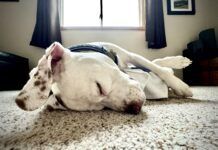A telltale sign of early-stage kidney disease in dogs is increased thirst, which results in increased urination. You may be filling the water bowl more during the day because your dog is so thirsty. Of course, your dog is asking to go out more often or he is having accidents in the house. His urine may have a strong odor.
Sadly, with chronic renal failure, this change can be so gradual that owners don’t notice until it is far along. And that’s frustrating because some chronic kidney disease cases are simply a result of old age. In other words, the dog’s tissues are wearing out.
In addition to the increased drinking and peeing, your dog’s appetite may be off, and he may be losing weight. Some dogs will be nauseous. Bad breath is common, and his gums may be pale. If your veterinarian checks a urine sample, the results may reveal excess protein or even some blood.
Fortunately, the kidneys are remarkable organs and can keep your dog humming along until close to two-thirds of their function is lost. If kidney disease is caught early enough, medical treatment can often give these dogs years of reasonable life.
As with so many health problems in our dogs, the prognosis is better if kidney failure is detected early. While kidney disease can’t be reversed, the progress of the disease can be slowed, giving your dog extra lifetime with good quality. Doing an annual complete blood panel and urinalysis starting at 7 years of age is ideal.
As chronic renal failure progresses, your dog may become anemic and lethargic. The buildup of toxins can lead to neurologic signs. Acute kidney failure is worse, such as from ingesting a toxic substance. These dogs are dramatically sick as there is an abrupt loss of ability to filter out toxins and retain the electrolytes and fluid that are important for good health.
What Causes Kidney Disease?
Kidney disease is common in dogs, and it has many causes, ranging from congenital defects that cause problems early on to a secondary ailment in senior dogs. It can be an acute episode from a toxin or a gradual decline in renal function.
Potential causes of kidney disease in dogs include:
- Congenital or Genetic Defects: Young puppies can suffer from congenital defects such as renal dysplasia and polycystic kidney disease. While these dogs can be managed, most have shortened lifespans.
Amyloidosis is another genetic kidney problem, often associated with Chinese Shar Peis. Puppies with early onset renal failure often drink and urinate excessively and may be difficult to house train. They are often noted as “failure to thrive,” lagging behind their littermates in growth and development.
- Ingestion of Toxins: Once we go beyond genetic defects (and some of those can show up clinically as late as 6 or 7 years of age), we are left with secondary kidney diseases. Toxins are high on the list for both acute kidney disease and chronic renal disease.
Acute poisoning, such as from acetaminophen (Tylenol), grapes and raisins, or ethylene glycol (antifreeze) can cause severe kidney disease, even fatalities. Immediate treatment can minimize damage, and some dogs recover completely. Toxic dogs are very sick dogs, however. You may notice vomiting, collapse, intense thirst, and seizures.
- Illness or Infection: Infections can damage kidneys, sometimes irreversibly. As Lyme disease (a tickborne illness) has become more prevalent, veterinarians are watching for Lyme nephritis. The first sign is generally protein spillover into the urine. Any bacterial or viral infection that affects the kidneys may cause kidney failure.
Detecting Early Stages of Kidney Failure in Dogs
As with so many health problems in our dogs, the prognosis is better if kidney failure is detected early. While kidney disease can’t be reversed, the progress of the disease can be slowed, giving your dog extra lifetime with good quality. Since signs of kidney disease in dogs may be subtle and easy to miss, doing an annual complete blood panel and urinalysis starting at 7 years of age is ideal.
Signs of kidney disease in dogs can include:
- Nausea: You might notice that your chowhound is not cleaning up all his meals or even skipping a meal now and then. He may walk over to his bowl, drool a bit, and then walk away.
- Increased water consumption: A solid symptom of kidney problems in a dog is having to fill the water bowl an extra time during the day because your dog is so thirsty.
- More frequent urination or urinating indoors: Your dog might start asking to go out every couple of hours instead of his normal four times a day or he is having accidents in the house. The urine may have a strong odor and a very dark color. You might even notice some blood.
- Energy and weight loss: Your dog may lose interest in playing and drop a few pounds.
- Bad breath: When you brush your dog’s teeth, you may think his breath seems worse than usual.
- Pale gums: His gums are likely pale instead of their normal shade of pink.
- Ulcers in the mouth: You might notice sores on his gums.
- Vomiting and Diarrhea: Some dogs will vomit occasionally and, although rarely, a dog may have diarrhea.
- Weakness: Weakness in the rear, mimicking fatigue, may be noted.
These symptoms are not specific for renal problems and can indicate other health issues, like diabetes, heatstroke, and liver disease. If more than one of the symptoms listed above is present, you should see your veterinarian. If possible, bring a fresh, clean urine sample and expect to have some bloodwork to be ordered.
Signs of Late-Stage Kidney Disease in Dogs
There is no cure for kidney disease, and it is a progressive disease. As chronic renal failure progresses, your dog may become anemic and lethargic. The buildup of toxins can lead to neurologic signs. At the end stages, your dog drastically worsens with lethargy, weakness (possibly including the hind end), vomiting, and a lack of thirst and urination. As the kidneys fail, they no longer produce urine.
Symptoms of Acute Kidney Failure
The signs noted above are for chronic kidney disease that takes a while to become evident. If your dog has , such as from a toxin exposure, he will be very sick, with vomiting, drinking large amounts or almost no water, and no appetite at all. Head right out to your veterinary clinic.
How To Treat Kidney Disease in Dogs
Like many diseases, kidney disease has “staging” protocols that recommend different treatments for each stage. The International Renal Interest Society has four stages for dogs in renal failure, using objective data from serum creatinine levels, plus looking at blood pressure and protein spills in the urine.
Depending on your dog’s stage, medical treatment will take into consideration hydration and nutrition first. Canned food, adding water to your dog’s meals, and eventually giving fluids subcutaneously can help to keep your dog hydrated.
From a dietary point of view, you want a diet with a lower protein amount—but still high quality for overall health—less dietary sodium and phosphorus, more B vitamins, more omega 3 fatty acids, and plenty of fiber. Several prescription diets that fit these parameters, or your veterinarian can guide you to sites that can provide custom balanced recipes for your dog, like Balance It.
Many dogs benefit from phosphate binders and medications to control blood pressure. Darbepoetin is a synthetic form of erythropoietin that may be recommended to battle anemia.
Dialysis is rarely used for dogs with chronic kidney disease but can truly be a lifesaver for a dog with acute, toxic renal failure. In these cases, dialysis is generally done for a short period of time. Unfortunately, there are very few places, primarily veterinary colleges, that currently offer dialysis.
While kidney transplants are done with some frequency in cats, they have not been as successful in dogs. There must be a compatible donor (which you are then responsible for adopting) and follow-up care is extensive, requiring immunosuppressive drugs for the lifetime of your dog. Transplants have not been as successful in dogs as cats.
SDMA stands for symmetric dimethylarginine, which is an amino acid. This is used as a biomarker to evaluate kidney function in dogs and cats. This is one of the earliest and most sensitive tests for changes in renal function, showing increased levels with as little as 25% of kidney function being compromised. In addition, it is not as sensitive to some of the environmental factors that can influence tests for kidney health such as muscle mass and diet.
SDMA is now included in many senior pet blood panels, but if not, you should request it for your older dog. Test results over 14 micrograms/dl suggest renal problems developing, so further diagnostics will be recommended.
The bottom line: If caught early on, many dogs can have years of reasonable quality of life with a kidney problem. They will require consistent, and sometimes comprehensive, care, but they can be active and comfortable.






